|

|
|
|
The Six Goswamis
BY: SUN STAFF
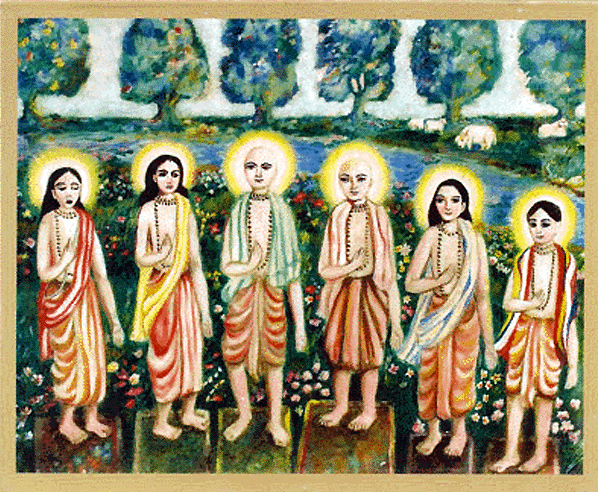
The Six Goswamis
Sri Rupa, Sri Sanatana, Bhatta Raghunatha, Sri Jiva, Gopala Bhatta, and Dasa Raghunatha
Oct 11, 2020 — CANADA (SUN) —
"I offer my respectful obeisances unto the six Gosvamis – Sri Rupa Gosvami, Sri Sanatana Gosvami, Sri Raghunatha Bhatta Gosvami, Sri Raghunatha dasa Gosvami, Sri Jiva Gosvami, and Sri Gopala Bhatta Gosvami--who cast off all aristocratic association as insignificant. To deliver poor, conditioned souls, they accepted loincloths and became mendicants, but they were always merged in the ecstatic ocean of the gopis' love for Krsna, and they were always bathing repeatedly in the waves of that ocean."
Path of Perfection, Chapter 6

"There were six great Gosvamis of Vrndavana--Srila Rupa, Sanatana, Bhatta Raghunatha, Sri Jiva, Gopala Bhatta and Dasa Raghunatha--and none of them inherited the title of gosvami. All the Gosvamis of Vrndavana were bona fide spiritual masters situated on the highest platform of devotional service, and for that reason they were called gosvamis. All the temples of Vrndavana were certainly started by the six Gosvamis. Later the worship in the temples was entrusted to some householder disciples of the Gosvamis, and since then the hereditary title of gosvami has been used. However, only one who is a bona fide spiritual master expanding the cult of Sri Caitanya Mahaprabhu, the Krsna consciousness movement, and who is in full control of his senses can be addressed as a gosvami. Unfortunately, the hereditary process is going on; therefore at the present moment, in most cases the title is being misused due to ignorance of the word's etymology.
Caitanya-caritamrta, Madyam lila 9:289

"By the will of the supreme gardener, the branches of Srila Rupa Gosvami and Sanatana Gosvami grew many times over, expanding throughout the western countries and covering the entire region. Extending to the borders of the river Sindhu and the Himalayan Mountain valleys, these two branches expanded throughout India, including all the places of pilgrimage, such as Vrndavana, Mathura and Haridvara. The fruits of love of Godhead which fructified on these two branches were distributed in abundance. Tasting these fruits, everyone became mad after them.
The people in general on the western side of India were neither intelligent nor well behaved, but by the influence of Srila Rupa Gosvami and Sanatana Gosvami they were trained in devotional service and good behavior.
Caitanya-caritamrta, Adi lila, Chapter 10

"The six Gosvamis, namely, Sri Sanatana Gosvami, Sri Rupa Gosvami, Sri Raghunatha Bhatta Gosvami, Sri Raghunatha dasa Gosvami, Sri Jiva Gosvami, and Sri Gopala Bhatta Gosvami, are very expert in scrutinizingly studying the revealed scriptures with the aim of establishing eternal religious principles for the benefit of all human beings. They are always absorbed in the mood of the gopis and are engaged in the transcendental loving service of Radha and Krsna." (Sad-gosvamy-astaka 2)
Science of Self-Realization, Chapter 7

"The six Gosvamis, under the direction of Srila Rupa Gosvami and Srila Sanatana Gosvami, studied various Vedic scriptures and picked up the essence of them, the devotional service of the Lord. This means that all the Gosvamis wrote many scriptures on devotional service with the support of the Vedic literature. Devotional service is not a sentimental activity. The essence of Vedic knowledge is devotional service, as confirmed in the Bhagavad-gita (15.15): vedais ca sarvair aham eva vedyah. All the Vedic literature aims at understanding Krsna, and how to understand Krsna through devotional service has been explained by Srila Rupa and Sanatana Gosvamis, with evidence from all the Vedic scriptures. They have put it so nicely that even a rascal or first-class fool can be delivered by devotional service under the guidance of the Gosvamis."
Caitanya-caritamrta, Madyam lila 1:33

"The Gosvamis, they left so many books handwritten, that when they were dispatched it was a full cartload, a big cartload, you see. Just imagine how many books they wrote. They were great scholars, and many varieties of books of bhakti school, Krsna consciousness, they wrote. So these Gosvamis were engaged, krsnotkirtana-gana-nartana, chanting and dancing. Kirtana means chanting, and nartana means dancing. Krsnotkirtana, utkirtana. Utkirtana means very loudly, not softly."
Srila Prabhupada Lecture, 11-18-68, Los Angeles
Srila Rupa Gosvami

Sri Rupa Gosvami
Srila Rupa Gosvami took his birth in 1493 A.D. (1415, Sakabda), and disappeared at the age of 73 in 1564 A.D. (1486, Sakabda). He spent 22 years in householder life, followed by 51 years in Vrndavana. Rupa Gosvami is known as bhakti-rasacarya, an expert in the tastes of pure devotional service. He and his older brother, Srila Sanatana Gosvami, left high posts in the government of Nawab Hussein Shah to join Sri Caitanya Mahaprabhu. Empowered by Lord Caitanya, Srila Rupa Gosvami wrote many books about the science of Krsna Consciousness. A summary study of his Bhakti-rasasmrta-sindhu can be found in "The Nectar of Devotion," and his Upadesamrta is found in "The Nectar of Instruction".

"Lord Sri Caitanya Mahaprabhu then sent the two brothers Srila Rupa Gosvami and Srila Sanatana Gosvami to Vraja. By His order, they went to Sri Vrndavana-dhama. After going to Vrndavana, the brothers preached devotional service and discovered many places of pilgrimage. They specifically initiated the service of Madana-mohana and Govindaji.
"Both Rupa Gosvami and Sanatana Gosvami brought various scriptures to Vrndavana and collected the essence of these by compiling many scriptures on devotional service. In this way they delivered all rascals and fallen souls.
"The Gosvamis carried out the preaching work of devotional service on the basis of an analytical study of all confidential Vedic scriptures. This was in compliance with the order of Sri Caitanya Mahaprabhu. Thus one can understand the most confidential devotional service of Vrndavana."
Caitanya-caritamrta, Madyam lila 1:32-34

During the Ratha-yatra ceremony Rupa Gosvami heard a verse uttered by Sri Caitanya Mahaprabhu during the ceremony, and he immediately composed another verse dealing with the same subject. Only Svarupa Damodara Gosvami knew the purpose for which the Lord recited that verse. According to the Lord's attitude, he used to quote other verses to enable the Lord to relish mellows. Rupa Gosvami, however, could understand the intention of the Lord, and thus he composed another verse. After writing this verse on a palm leaf, he put it somewhere in his thatched roof and went to bathe in the sea. At that time, Sri Caitanya Mahaprabhu went there to meet him, and when He saw the leaf pushed into the roof and saw the verse, He read it and was overwhelmed by ecstatic love. At that time Rupa Gosvami returned and offered his obeisances. The Lord slapped him mildly in love and said, "My heart is very confidential. How did you know My mind in this way?" Svarupa Damodara said, "I can understand that You have already bestowed Your causeless mercy upon him. No one could otherwise understand this meaning."
Gaudiya Vaisnava Abhidhana, p. 1350-1351
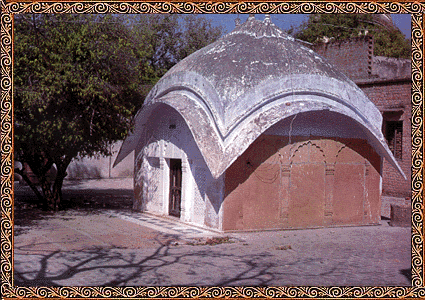
Rupa Gosvami's Samadhi at Vrindaban
"In the Gaura-ganoddesa-dipika (180) Sri Rupa Gosvami is described to be the gopi named Sri Rupa-manjari. In the Bhakti-ratnakara there is a list of the books Sri Rupa Gosvami compiled. Of all his books, the following sixteen are very popular among Vaisnavas: (1) Hamsaduta, (2) Uddhava-sandesa, (3) Krsna-janma-tithi-vidhi, (4 and 5) Radha-krsna-ganoddesa-dipika, Brhat (major) and Laghu (minor), (6) Stavamala, (7) Vidagdha-madhava, (8) Lalita-madhava, (9) Dana-keli-kaumudi, (10) Bhakti-rasamrta-sindhu (this is the most celebrated book by Sri Rupa Gosvami), (11) Ujjvala-nilamani, (12) Akhyata-candrika, (13) Mathura-mahima, (14) Padyavali, (15) Nataka-candrika and (16) Laghu-bhagavatamrta. Sri Rupa Gosvami gave up all family connections, joined the renounced order of life and divided his money, giving fifty percent to the brahmanas and Vaisnavas and twenty-five percent to his kutumba (family members) and keeping twenty-five percent for personal emergencies. He met Haridasa Thakura in Jagannatha Puri, where he also met Lord Caitanya and His other associates. Sri Caitanya Mahaprabhu used to praise the handwriting of Rupa Gosvami. Srila Rupa Gosvami could compose verses according to the desires of Sri Caitanya Mahaprabhu, and by His direction he wrote two books named Lalita-madhava and Vidagdha-madhava. Lord Caitanya desired the two brothers, Sanatana Gosvami and Rupa Gosvami, to publish many books in support of the Vaisnava religion."
Caitanya-caritamrta, Adi lila 10:84
Srila Sanatana Gosvami
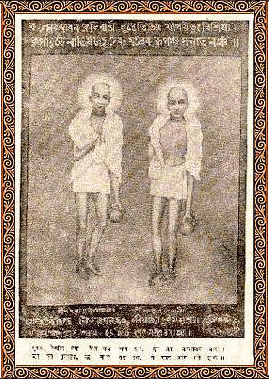
Sri Sanatana and Rupa Gosvamis
Sri Sanatana Gosvami took his birth in 1488 A.D. (1410, Sakabda). As a child, he began his studies along with his brothers, from their maternal uncle's house in a small village called Sakurma near the capital of Gaura-desa. At the age of 27 he came to live at Braja, and remained there for 43 years. At the age of 70, Srila Sanatana disappeared on the full moon day of Asar in the year 1558 A.D.
In the conclusion of his commentary on the Bhagavata, the Laghu-Vaisnava-Toshani, Jiva Goswami describes the ancestral line of his uncle, Sanatana Goswami. This genealogy states that there was a king in Karnataka called Srisarvajana, who was known as Jagadguru due to his learning. Srisarvajana's descendant, Aniruddha, gave his kingdom equally to his two sons, Harihara and Rupesvara, but Harihara forcibly occupied Rupesvara's dominion and drove him away. Rupesvara then left Karnataka, taking shelter with King Sikharesvara of Paurastya. He later retired to Navahatta (Naihati near Kalna) in Bengal, where he associated with king Danujamardana. His grandson, Kumaradeva, moved to Bakla Candradvipa (East Pakistan). Rupa, Sanatana, and Anupama were among the many sons born in this brahmana family.
As the elder brother of Srila Rupa Gosvami, Sanatana was the topmost among the six Gosvamis of Vrndavana. Lord Caitanya Mahaprabhu instructed him at Varanasi, teaching him the detailed science of devotional service. Lord Caitanya sent Srila Sanatana Gosvami to Vrndavana and gave him a fourfold mission: to uncover the lost sites of Krsna's pastimes, to install deities of the Lord and arrange for Their worship, to write books on Krsna consciousness, and to teach the rules of devotional life. Srila Sanatana Gosvami, with the help of Srila Rupa Gosvami, fulfilled all parts of this mission.
Sri Sanatana Gosvami compiled many scriptures, including: Sri Brhad-bhagavatmrta, Sri Hari-bhakti-vilas and its Dig-darsani-tika, Sri Krsna-lilastava (dasam carit), Sri Bhagavata-tipani (Dasama-tippani) (commentary on Srimad Bhagavatam), Brihat-vaisnava-tosani (Laghu-tosani), and Dasama-carita.
Sanatana Goswami's trancendental position is glorified in Sri Kavi-Karnapura's Gaura-Ganodesha-Dipika (181):
sa rupa-manjari-prestha
purasid rati-manjari
socyate nama-bhedena
lavanga-manjari budhaih
"Rupa Manjari's closest friend, who is know by the names Rati-Manjari and Lavanga-Manjari, appeared in the pastimes of Shri Chaitanya Mahaprabhu as Shri Sanatana Goswami, who is considered to be a personal extension of the body of Shri Chaitanya Mahaprabhu."

"Sri Sanatana Gosvami is described in the Gaura-ganoddesa-dipika (181). He was formerly known as Rati-manjari or sometimes Lavanga-manjari. In the Bhakti-ratnakara it is stated that his spiritual master, Vidyavacaspati, sometimes stayed in the village of Ramakeli, and Sanatana Gosvami studied all the Vedic literature from him. He was so devoted to his spiritual master that this cannot be described. According to the Vedic system, if someone sees a Muslim he must perform rituals to atone for the meeting. Sanatana Gosvami always associated with Muslim kings. Not giving much attention to the Vedic injunctions, he used to visit the houses of Muslim kings, and thus he considered himself to have been converted into a Muslim. He was therefore always very humble and meek. When Sanatana Gosvami presented himself before Lord Caitanya Mahaprabhu, he admitted, "I am always in association with lower-class people, and my behavior is therefore very abominable." He actually belonged to a respectable brahmana family, but because he considered his behavior to be abominable, he did not try to place himself among the brahmanas but always remained among people of the lower castes. He wrote the Hari-bhakti-vilasa and Vaisnava-tosani, which is a commentary on the Tenth Canto of Srimad-Bhagavatam. In the year 1476 Sakabda (A.D. 1555) he completed the Brhad-vaisnava-tosani commentary on Srimad-Bhagavatam. In the year 1504 Sakabda (A.D. 1583) he finished the Laghu-tosani."
Caitanya-caritamrta, Adi lila 10:84

"In the First Wave of the book known as Bhakti-ratnakara, it is said that Sanatana Gosvami understood Srimad-Bhagavatam by thorough study and explained it in his commentary known as Vaisnava-tosani. All the knowledge that Sri Sanatana Gosvami and Rupa Gosvami directly acquired from Sri Caitanya Mahaprabhu was broadcast all over the world by their expert service. Sanatana Gosvami gave his Vaisnava-tosani commentary to Srila Jiva Gosvami for editing, and Srila Jiva Gosvami edited this under the name of Laghu-tosani. Whatever he immediately put down in writing was finished in the year 1476 Saka (A.D. 1555). Srila Jiva Gosvami completed Laghu-tosani in the year Sakabda 1504 (A.D. 1583)."
Caitanya-caritamrta, Madyam lila 1:35

"The Fourth Chapter of Antya-lila is summarized by Bhaktivinoda Thakura in his as follows. Srila Sanatana Gosvami came alone from Mathura to Jagannatha Puri to see Lord Caitanya. Because of bathing in bad water and not getting enough food every day while traveling on the path through Jharikhanda Forest, he developed a disease that made his body itch. Suffering greatly from this itching, he resolved that in the presence of Sri Caitanya Mahaprabhu he would throw himself under the wheel of Jagannatha's car and in this way commit suicide.
When Sanatana Gosvami came to Jagannatha Puri, he stayed under the care of Haridasa Thakura for some time, and Sri Caitanya Mahaprabhu was very happy to see him. The Lord informed Sanatana Gosvami about the death of his younger brother, Anupama, who had great faith in the lotus feet of Lord Ramacandra. One day Sri Caitanya Mahaprabhu said to Sanatana Gosvami, "Your decision to commit suicide is the result of the mode of ignorance. One cannot get love of God simply by committing suicide. You have already dedicated your life and body to My service; therefore your body does not belong to you, nor do you have any right to commit suicide. I have to execute many devotional services through your body. I want you to preach the cult of devotional service and go to Vrndavana to excavate the lost holy places." After having thus spoken, Sri Caitanya Mahaprabhu left, and Haridasa Thakura and Sanatana Gosvami had many talks about this subject.
One day Sanatana Gosvami was summoned by Sri Caitanya Mahaprabhu, who wanted him to come to Yamesvara-tota. Sanatana Gosvami reached the Lord through the path along the beach by the sea. When Sri Caitanya Mahaprabhu asked Sanatana Gosvami which way he had come, Sanatana replied, "Many servitors of Lord Jagannatha come and go on the path by the Simha-dvara gate of the Jagannatha temple. Therefore, I did not go by that path, but instead went by the beach." Sanatana Gosvami did not realize that there were burning blisters on his feet because of the heat of the sand. Sri Caitanya Mahaprabhu was pleased to hear about Sanatana Gosvami's great respect for the temple of Lord Sri Jagannatha.
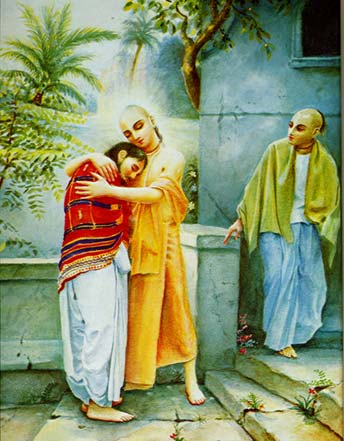 Because his disease produced wet sores on his body, Sanatana Gosvami used to avoid embracing Sri Caitanya Mahaprabhu, but nevertheless the Lord would embrace him by force. This made Sanatana Gosvami very unhappy, and therefore he consulted Jagadananda Pandita about what he should do. Jagadananda advised him to return to Vrndavana after the cart festival of Jagannatha, but when Sri Caitanya Mahaprabhu heard about this instruction, He chastised Jagadananda Pandita and reminded him that Sanatana Gosvami was senior to him and also more learned, Sri Caitanya Mahaprabhu informed Sanatana Gosvami that because Sanatana was a pure devotee, the Lord was never inconvenienced by his bodily condition. Because the Lord was a sannyasi, He did not consider one body better than another. The Lord also informed him that He was maintaining Sanatana and the other devotees just like a father. Therefore the moisture oozing from Sanatana's itching skin did not affect the Lord at all. After speaking with Sanatana Gosvami in this way, the Lord again embraced him, and after this embrace, Sanatana Gosvami became free from the disease. The Lord ordered Sanatana Gosvami to stay with Him for that year, and the next year, after seeing the Ratha-yatra festival, he left Purusottama-ksetra and returned to Vrndavana.
After meeting Sri Caitanya Mahaprabhu, Sri Rupa Gosvami also returned to Bengal, where he remained for one year. Whatever money he owned, he distributed among his relatives, the brahmanas and the temples. In this way he completely retired and returned to Vrndavana to meet Sanatana Gosvami.
After narrating these incidents, Krsnadasa Kaviraja Gosvami has given a list of the main books of Sanatana Gosvami, Srila Rupa Gosvami and Jiva Gosvami."
Caitanya-caritamrta, Antya lila, Introduction
Srila Bhatta Raghunatha Goswami
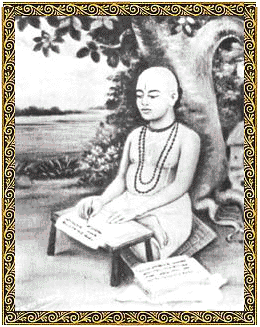
Bhatta Raghunatha
"Raghunatha Bhattacarya, or Raghunatha Bhatta Gosvami, one of the six Gosvamis, was the son of Tapana Misra. Born in approximately 1425 Sakabda (A.D. 1504), he was expert in reciting Srimad-Bhagavatam, and in the Antya-lila, Chapter Thirteen, it is stated that he was also expert in cooking; whatever he cooked would be nectarean. Sri Caitanya Mahaprabhu was greatly pleased to accept the food that he cooked, and Raghunatha Bhatta used to take the remnants of food left by Sri Caitanya Mahaprabhu. Raghunatha Bhattacarya lived for eight months in Jagannatha Puri, after which Lord Caitanya ordered him to go to Vrndavana to join Sri Rupa Gosvami. Sri Caitanya Mahaprabhu asked Raghunatha Bhattacarya not to marry but to remain a brahmacari, and He also ordered him to read Srimad-Bhagavatam constantly. Thus he went to Vrndavana, where he engaged in reciting Srimad-Bhagavatam to Srila Rupa Gosvami. He was so expert in reciting Srimad-Bhagavatam that he would recite each and every verse in three melodious tunes. While Raghunatha Bhatta Gosvami was living with Sri Caitanya Mahaprabhu, the Lord blessed him by offering him betel nuts offered to the Jagannatha Deity and a garland of tulasi said to be as long as fourteen cubits. Under Raghunatha Bhatta Gosvami's order, one of his disciples constructed the Govinda temple. Raghunatha Bhatta Gosvami supplied all the ornaments of the Govinda Deity. He never talked of nonsense or worldly matters but always engaged in hearing about Krsna twenty-four hours a day. He never cared to hear blasphemy of a Vaisnava. Even when there were points to be criticized, he used to say that since all the Vaisnavas were engaged in the service of the Lord, he did not mind their faults. Later Raghunatha Bhatta Gosvami lived by Radha-kunda in a small cottage. In the Gaura-ganoddesa-dipika, verse 185, it is said that Raghunatha Bhatta Gosvami was formerly the gopi named Raga-manjari."
Caitanya-caritamrta, Adi lila 10:158
Srila Jiva Gosvami
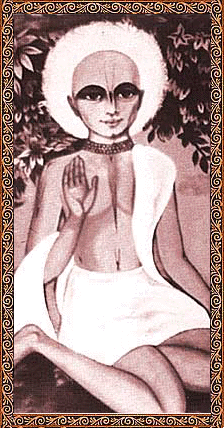
Jiva Gosvami
Srila Jiva Gosvami made his appearance in 1455, Sakabdha (1533 A.D.), on the 12th day of the bright fortnight in the month of Bhadra. He disappeared from view at the age of 85 in 1540 A.D., (Sakabdha, 3rd day of bright fortnight, Pausa).
As a child, Sri Jiva took up the worship of Sri-Sri Rama-Krsna Deities. Carefully decorating Them, and offering bhoga and arati, he served Them attentively. Even when playing, Jivas games were often connected with Lord Krsna's pastimes.
Sri Jiva studied under the local pandits, becoming proficient in grammar, poetry and rhetoric. Watching the expression of his great intellect, his teachers predicted that he would be a very saintly person. Later in his life, he composed a grammar in Sanskrit for the pleasure of the Lord. This composition described the rules of grammar, which was explained with examples that used the holy names of the Lord. Known as Hari-namamrta-vyakarana, this grammar is still current and is prescribed in the syllabus of schools in Bengal.
Once in a dream, Sri Jiva saw that Sri Rama-Krsna had taken the forms of Nitai-Gauranga, and they were dancing. Giving him the dust of Their lotus feet, the Two Lords then disappeared. This wonderful dream greatly consoled Sri Jiva, who was anxious to leave behind his family life and become absorbed full time in serving Nitai-Gauranga. But, being the only son of the family, and in the absence of his father, Jiva was responsible for the care of his mother. When he learned that his father had left his body on the banks of the Ganges, Sri Jiva became extremely saddened. Friends suggested that he go to Navadwipa to bathe himself in the coolness emanating from the lotus feet of Lord Nityananda Prabhu, so that burning grief in his mind and body might be refreshed. As Sri Jiva headed for Navadwipa with a group of pilgrims, Nityananda Prabhu also set out for Navadwipa, from Khardaha. Arriving in Navadwipa, at the home of Srivasa Pandita, Sri Jiva met and fell down at the feet of Nityananada Prabhu.
Sri Jiva enjoyed various pastimes with Nityananda Prabhu, touring the nine islands of Navadwipa and taking darsana of the holy places of the Lord's pastimes. Jiva then traveled to Kasi (Varanasi), where he studied Vedanta under the instruction of Sri Madhusudana Vacaspati, a disciple of Sarvabhauma Bhattacarya. The conclusions of Vedanta contained in Srimad-Bhagavatam, as they were given by Sri Caitanya Mahaprabhu to Sarvabhauma Bhattacarya in Puri, had in turn been taught by the Bhattacarya to Madhusudana Vacaspati. Sri Jvia mastered these same conclusions from him.
Sri Jiva later traveled to Vrindavana, where he joined the company of his two uncles, Sri Rupa and Sri Sanatana. Jiva stayed with Sri Rupa, who taught him Srimad Bhagavatam and gave him mantra initiation. Sri Jvia quickly become conversant with the conclusion of Srimad Bhagavatam, so Sri Rupa engaged him in proof-reading his Bhakti-rasamrta-sindhu. Sri Jiva compiled a commentary on Bhakti-rasamrta-sindhu called Durgama sangamani. Later, in 1476 (Sakabda), Sri Sanatana Gosvami compiled Sri Vaisnava tosani, a commentary on the tenth canto of Srimad-Bhagavatam, which Jiva also proofread. Following Sanatana's instruction, in 1500 (Sakabda) Sri Jiva compiled a commentary on the Bhagavatam called Laghu Vaisnava tosani.
While in Vrindavana, Sri Rupa took up the service of Sri Sri Radha-Damodara. According to the Sadhana dipika, this Deity of Damodara was fashioned by Rupa Gosvami's own hand for his dear disciple, Sri Jiva. Today, Sri Sri Radha-Damodara are being worshipped in Jaipur, Rajasthan.
Srila Jiva Gosvami composed many literatures during his lifetime, including:
Hari-namamrta-vyakarana
Sutra-malika
Rasamrta-sesa
Gopala-virudavali
Sri-Madhava-mahotsava
Sri-Sankalpa-kalpavrksa
Brahma-Samhita-tika
Bhakti-rasamrta-sindhu-tika (Durgama-sangamani)
Ujjvala-nilamani-tika (Locana-rocani)
Gopala-campu
Sat-sandharbha (Tattva-sandarbha, Bhagavata-sandarbha, Paramatma sandarbha, Krsna-sandarbha, Bhakti-sandharbha, Priti-sandarbha)
Srimad-Bhagavata-tika (Krama-sandarbha)
Laghu-vaisnava-tosani (Tenth Canto Bhagavatam commentary)
Sarva-sambadina (commentary on Sat-sandarbha)
Gopala-tapani-tika (Sri-Suhkha-bodhini)
Padma-puranastha-yogasara-stotra-tika
Gayatri-vyakhya-vivrti (A commentary on the Gayatri mantra as described in the Agni Purana, chapters 216-217)
Radha-Krsnarcana-candrika
Dhatu-sangraha
Bhavartha-sucaka-campu
Srila Gopala Bhatta Gosvami

The Six Goswamis
"Sri Gopala Bhatta Gosvami, the forty-seventh branch, was one of the great and exalted branches of the tree. He always engaged in discourses about love of Godhead in the company of Rupa Gosvami and Sanatana Gosvami."
"Sri Gopala Bhatta Gosvami was the son of Venkata Bhatta, a resident of Srirangam. Gopala Bhatta formerly belonged to the disciplic succession of the Ramanuja-sampradaya but later became part of the Gaudiya-sampradaya. In the year 1433 sakabda (A.D. 1512), when Lord Caitanya Mahaprabhu was touring South India, He stayed for four months during the period of Caturmasya at the house of Venkata Bhatta, who then got the opportunity to serve the Lord to his heart's content. Gopala Bhatta also got the opportunity to serve the Lord at this time. Sri Gopala Bhatta Gosvami was later initiated by his uncle, the great sannyasi Prabodhananda Sarasvati. Both the father and mother of Gopala Bhatta Gosvami were extremely fortunate, for they dedicated their entire lives to the service of Lord Caitanya Mahaprabhu. They allowed Gopala Bhatta Gosvami to go to Vrndavana, and they gave up their lives thinking of Sri Caitanya Mahaprabhu. When Lord Caitanya was later informed that Gopala Bhatta Gosvami had gone to Vrndavana and met Sri Rupa and Sanatana Gosvami, He was very pleased, and He advised Sri Rupa and Sanatana to accept Gopala Bhatta Gosvami as their younger brother and take care of him. Sri Sanatana Gosvami, out of his great affection for Gopala Bhatta Gosvami, compiled the Vaisnava smrti named Hari-bhakti-vilasa and published it under his name. Under the instruction of Srila Rupa and Sanatana, Gopala Bhatta Gosvami installed one of the seven principal Deities of Vrndavana, the Radharamana Deity. The sevaits (priests) of the Radharamana temple belong to the Gaudiya-sampradaya.
When Krsnadasa Kaviraja Gosvami took permission from all the Vaisnavas before writing Sri Caitanya-caritamrta, Gopala Bhatta Gosvami also gave him his blessings, but he requested him not to mention his name in the book. Therefore Krsnadasa Kaviraja Gosvami has mentioned Gopala Bhatta Gosvami only very cautiously in one or two passages of the Caitanya-caritamrta. Srila Jiva Gosvami has written in the beginning of his Tattva-sandarbha, "A devotee from southern India who was born of a brahmana family and was a very intimate friend of Rupa Gosvami and Sanatana Gosvami has written a book that he has not compiled chronologically. Therefore I, a tiny living entity known as jiva, am trying to assort the events of the book chronologically, consulting the direction of great personalities like Madhvacarya, Sridhara Svami, Ramanujacarya and other senior Vaisnavas in the disciplic succession." In the beginning of the Bhagavat-sandarbha there are similar statements by Srila Jiva Gosvami. Srila Gopala Bhatta Gosvami compiled a book called Sat-kriya-sara-dipika, edited the Hari-bhakti-vilasa, wrote a forword to the Sat-sandarbha and a commentary on the Krsna-karnamrta, and installed the Radharamana Deity in Vrndavana. In the Gaura-ganoddesa-dipika, verse 184, it is mentioned that his previous name in the pastimes of Lord Krsna was Ananga-manjari. Sometimes he is also said to have been an incarnation of Guna-manjari. Srinivasa Acarya and Gopinatha Pujari were two of his disciples."
Caitanya-caritamrta, Adi lila 10:105
Srila Raghunatha dasa Gosvami
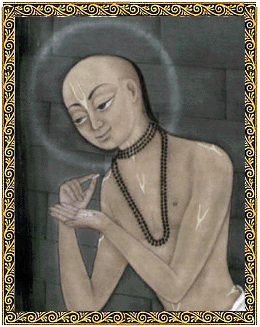
Raghunatha dasa Gosvami
"Lord Sri Caitanya Mahaprabhu had three Raghus among His associates--Vaidya Raghunatha (vide Adi-lila 11.22), Bhatta Raghunatha and Dasa Raghunatha. Dasa Raghunatha became celebrated as the Raghunatha of Svarupa."
Caitanya-caritamrta, Antya lila 6:203

"Srila Raghunatha dasa Gosvami, the forty-sixth branch of the tree, was one of the most dear servants of Lord Caitanya Mahaprabhu. He left all his material possessions to surrender completely unto the Lord and live at His lotus feet. When Raghunatha dasa Gosvami approached Sri Caitanya Mahaprabhu at Jagannatha Puri, the Lord entrusted him to the care of Svarupa Damodara, His secretary. Thus they both engaged in the confidential service of the Lord. He rendered confidential service to the Lord for sixteen years at Jagannatha Puri, and after the disappearance of both the Lord and Svarupa Damodara, he left Jagannatha Puri and went to Vrndavana. Srila Raghunatha dasa Gosvami intended to go to Vrndavana to see the lotus feet of Rupa and Sanatana and then give up his life by jumping from Govardhana Hill. Thus Srila Raghunatha dasa Gosvami came to Vrndavana, visited Srila Rupa Gosvami and Sanatana Gosvami and offered them his obeisances. These two brothers, however, did not allow him to die. They accepted him as their third brother and kept him in their company.
Because Raghunatha dasa Gosvami was an assistant to Svarupa Damodara, he knew much about the external and internal features of the pastimes of Lord Caitanya. Thus the two brothers Rupa and Sanatana always used to hear of this from him. Raghunatha dasa Gosvami gradually gave up all food and drink but a few drops of buttermilk. As a daily duty, he regularly offered one thousand obeisances to the Lord, chanted at least one hundred thousand holy names and offered obeisances to two thousand Vaisnavas. Day and night he rendered service within his mind to Radha-Krsna, and for three hours a day he discoursed about the character of Lord Caitanya Mahaprabhu. Sri Raghunatha dasa Gosvami took three baths daily in the Radha-kunda lake. As soon as he found a Vaisnava residing in Vrndavana, he would embrace him and give him all respect. He engaged himself in devotional service for more than twenty-two and a half hours a day, and for less than two hours he slept, although on some days that also was not possible. I am struck with wonder when I hear about the devotional service he executed."
Caitanya-caritamrta, Adi lila 10:91:103

"A summary of this chapter is given by Bhaktivinoda Thakura in his Amrta-pravaha-bhasya as follows. When Sri Caitanya Mahaprabhu went into transcendental fits of ecstatic love, Ramananda Raya and Svarupa Damodara Gosvami attended to Him and satisfied Him as He desired. Raghunatha dasa Gosvami had been attempting to come to the lotus feet of Sri Caitanya Mahaprabhu for a long time, and finally he left his home and met the Lord. When Sri Caitanya Mahaprabhu had gone to Santipura on His way to Vrndavana, Raghunatha dasa Gosvami had offered to dedicate his life at the Lord's lotus feet. In the meantime, however, a Mohammedan official became envious of Hiranya dasa, Raghunatha dasa Gosvami's uncle, and induced some big official court minister to have him arrested. Thus Hiranya dasa left his home, but by the intelligence of Raghunatha dasa the misunderstanding was mitigated. Then Raghunatha dasa went to Panihati, and, following the order of Nityananda Prabhu, he observed a festival (cida-dadhi-mahotsava) by distributing chipped rice mixed with yogurt. The day after the festival, Nityananda Prabhu gave Raghunatha dasa the blessing that he would very soon attain the shelter of Sri Caitanya Mahaprabhu. After this incident, Raghunatha dasa, with the help of his priest, whose name was Yadunandana Acarya, got out of his house by trickery and thus ran away. Not touching the general path, Raghunatha dasa Gosvami secretly went to Jagannatha Puri. After twelve days, he arrived in Jagannatha Puri at the lotus feet of Sri Caitanya Mahaprabhu.
Sri Caitanya Mahaprabhu entrusted Raghunatha dasa Gosvami to Svarupa Damodara Gosvami. Therefore another name for Raghunatha dasa Gosvami is Svarupera Raghu, or the Raghunatha of Svarupa Damodara. For five days Raghunatha dasa Gosvami took prasada at the temple, but later he would stand at the Simha-dvara gate and eat only whatever he could gather by alms. Later he lived by taking alms from various chatras, or food distributing centers. When Raghunatha's father received news of this, he sent some men and money, but Raghunatha dasa Gosvami refused to accept the money. Understanding that Raghunatha dasa Gosvami was living by begging from the chatras, Sri Caitanya Mahaprabhu presented him with His own gunja-mala and a stone from Govardhana Hill. Thereafter, Raghunatha dasa Gosvami used to eat rejected food that he had collected and washed. This renounced life greatly pleased both Svarupa Damodara Gosvami and Sri Caitanya Mahaprabhu. One day Sri Caitanya Mahaprabhu took by force some of the same food, thus blessing Raghunatha dasa Gosvami for his renunciation."
Caitanya-caritamrta, Antya lila, Chapter 6 Introduction
 Bhaktivedanta Book Trust. HDG A.C. Bhaktivedanta Swami Srila Prabhupada. Bhaktivedanta Book Trust. HDG A.C. Bhaktivedanta Swami Srila Prabhupada.

| The Sun |
News |
Editorials |
Features |
Sun Blogs |
Classifieds |
Events |
Recipes |
PodCasts |
| About |
Submit an Article |
Contact Us |
Advertise |
HareKrsna.com |
Copyright 2005, 2020, HareKrsna.com. All rights reserved.
|
|

